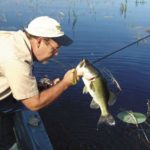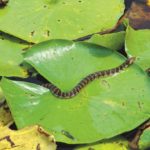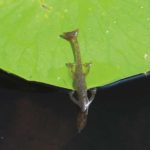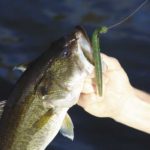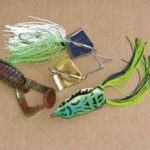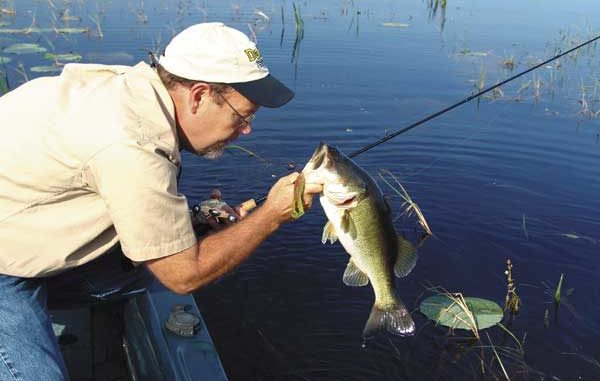
Work lily pads more effectively this summer, and you’ll put bunches of bass in the boat.
It’s like a beach umbrella for bass — shelter from the swelter and a nice place to enjoy a semi-private siesta. Lily pads, those broad green leaves that grow on stalks and look like big pie plates, comprise one of the most fundamental bass habitats throughout many Southern Louisiana waterways. During the heat of the day, bass tend to back themselves into heavy cover and snooze away the warmer hours. They may not feed as aggressively as they do during early morning and late-afternoon prime times, but pestering the fish with an intrusive presence will often draw aggressive reaction strikes.
Lily pads exemplify this principle. You’ll occasionally find bass around individual pads scattered amid grass lines, but a solid stand of these stalky plants with the flat, semi-rounded leaves and the brilliant white blossoms is like a treasure chest of rod-bending potential.
Covington angler Sam Swett competes on the BASS and FLW tours, and plucks largemouths from just about every type of habitat and structure imaginable. On a scale of 1-10, he ranks the pads an 8.
“This habitat does play a key role in my fishing because it means less current or a current break,” Swett said. “Also, the majority of our weather in South Louisiana is hot, so lily pads offer a lot of shade, plus the plants produce oxygen and that creates a comfortable environment for the fish.”
The general rule of thumb for bass fishing states that early mornings and late afternoons offer optimal conditions. The fish will feed around shallow vegetation and other structure during these cool times, but they’ll retreat to areas of moderate temperatures during the heat of the day.
A lot of folks rack their rods once the morning sun drives the bass into their shelter, but those who can stand the warmth often find largemouth action throughout the day. The key is cover, and several hundred pads growing together form a floating sun shield with lots of room underneath.
From a predatory perspective, a stand of lily pads offers multiple ambush points with low-light corridors and lots of hidey holes where the bass can sit in the shade and keep watch for possible meals. Concealed within the dark recesses, bass use these portals to spot and ambush passing prey. Summer’s heat pushes the fish farther into the cover, but the concept remains consistent.
Proceed with a plan
Swett takes a methodical approach to fishing lily pads. First, he’ll patrol the perimeter and then probe interior waters.
“Bream will swim along the edges of the pads, so that’s why I always work the edges first,” he said. “As the weather heats up and the water temperature rises, I’ll work into the deepest part of the vegetation that my trolling motor allows me to reach.”
For working the edges, Swett likes ½-ounce Booyah double willow spinnerbaits with white/chartreuse skirts. Larger blades — No. 7’s are his choice — provide a strategic combination of flash and vibration.
“Bigger blades provide more thump to bring the bass out if they’re buried up really deep,” he said.
Now, when bass do push far into a stand of pads, flipping jigs or Texas-rigged worms on long rods is a good option for precision presentations. These tactics prove very effective if you spot fish moving or feeding in a particular area, or if you want to probe a likely spot.
Tease from the top
Of course, if you don’t want to go to the fish, you can bring the fish to you. One way is working soft-plastic baits right across the pads — a tactic that’ll incite ornery bass to charge through the vegetation with violent intentions.
Most effective is a soft plastic worm like the original Senko, Yum Dinger or Tiki Stick rigged weightless with a Texas-style hook placement. Aerodynamic designs and dense bodies allow you to cast these worms long distances, while their featureless forms hop easily across pads. Hold the rod high and snap the tip if your bait nears the notch at the back of a pad. Snagging there usually means tying on a new bait.
Similar to frogging, skipping worms is pure reaction-strike bliss. Bass will literally bump the pads to try and shake off the meal. If that doesn’t work, expect a full-throttle attack that may bring the fish completely out of the water. Between these extremes, a little subtle taunting can push indecisive bass over the edge.
Sling your bait across the pads, retrieve it a few feet, and then pause to let the bait die and fall into holes among the vegetation. Bass unwilling to venture topside usually respond quickly to this sudden vulnerability.
For some, coming to the surface isn’t the problem; it’s a matter of making sure they get enough return on their investment of time and effort. Seal the deal by dragging your bait onto a pad and letting it teeter halfway over the edge. Wiggle your rod tip to make the bait dip up and down in the water to simulate a small snake or lizard making its move. If that doesn’t do the trick, there’s no one home.
As summer heat intensifies, anglers often turn to Yum Buzz Frogs, Gambler Cane Toads and similar soft-plastic frogs. Rigged weedless on wide-gap hooks, these baits feature paddle legs that kick like actual amphibians and create a lot of bass-bugging chatter.
When looking for these reaction bites, Swett prefers frogs to equally noisy buzz baits because the latter relies on finding lanes of open water. The frog can go anywhere — it’s the 4-wheel-drive bass bait.
“Sometimes, you may see an open hole to throw a buzz bait, but to get it back to you, there may not be enough open water,” Swett said.
In addition to frogs with paddle feet, those with smooth bodies and strictly ornamental appendages can also cause enough disturbance and intrusion to bring an irate largemouth charging forth. Smooth models like the Spro Frog can skip and bounce across the vegetation, pause, float and continue.
Let your frog sit for a few seconds in small pockets amid the pads, and then resume the retrieve. Vicious strikes often come right when the frog starts moving again. Just don’t make the mistake of yanking your bait away from the fish when you see the strike. As with topwater plugs, let the bass pull the frog under and come tight before trying to set the hook.
Gear up
Whatever he’s throwing, Swett believes in the power of persistence.
“I make repeated casts into the pads,” he said. “I won’t make just one cast and move on. I want to aggravate the bass.
“Sometimes they won’t strike it because they’re hungry; they just want to kill it and get it out of there. You’ll get some of the most aggressive strikes you can imagine.”
Proper tackle promotes effective pad fishing. For working edges with spinnerbaits, Swett uses a 6-foot-8 baitcasting outfit with 20-pound Berkley Silver Thread. He likes the shock absorbance that monofilament provides for a “tight” bait. Along the pads’ perimeter, there’s not much threat losing a fish to tangles, but 20-pound-test affords enough strength to turn a bass bound for cover.
Throwing inside with frogs or surface-skipping baits, Swett goes with 60-pound Spiderwire, as this provides an effective blend of castability, structure resistance and pulling power.
“When you’re making long casts into the lily pads, your landing rates go down considerably,” he said. “That’s why I use braid. If a fish wants to take that bait into the pads, I feel like I have enough line to pull him back out.”
Search pattern
A large stand of lily pads certainly holds great potential, but it’s often a feast-or-famine relationship. Burning daylight on a vacant section may sour your view of the entire area, but resist such generalizations. There’s usually a sweet spot, or at least a zone in which most of the bass will congregate.
Obvious features such as docks and timber deserve close inspection, but Swett uses his ears to complement his eyes. When attacking a large stand of pads, he’ll listen for the clicking and splashing of aquatic insects, along with the slurps of bream sucking down these meals. The bass will be near this activity, so that’s a good spot to work.
“The bass are not everywhere in the lily pads, so I look for something that will slow me down and make me really work that,” he said.
Swett also pays close attention to lily-pad depth. Pads grow mostly in about 2-5 feet. Swett notes the depths in which he’s getting his bites. A standard vertical sonar unit is helpful, but Swett takes the game to a higher level by employing a Humminbird side-imaging unit that shows structure and fish on his periphery. A transducer mounted on his trolling motor allows him to spy his way through structure and spot things he may not otherwise detect.
One of the key factors Swett seeks to detect is the active depth where most of the fish are holding.
“I may not find fish (continuously) in that zone, but I know that at least for that day, I can eliminate those other depths,” he said.
Whatever your level of experience and motivation, lily pads should remain on your target list.
“It’s something that cannot go overlooked,” Swett said. “If there are lily pads in a lake, I will always work them over. It may not be the dominant pattern for that day, but there are always bass living there.”
Some may feel intimidated by a large stand of lily pads, and that’s mostly due to an inability to read the structure and mount an effective attack. Anglers may fish the lily pads and catch a couple of fish but not really understanding why they caught them. Take time to study the structure, pay attention to where you’re catching fish, and then try to replicate what’s working.
“Don’t hesitate to fight your way through the heavy cover, or even use a push pole to get yourself deeper than your trolling motor can run,” Swett suggests. “If you do that, you’ll be fishing an area where no one has fished, so it’s an untapped resource that can produce a bonanza.”
